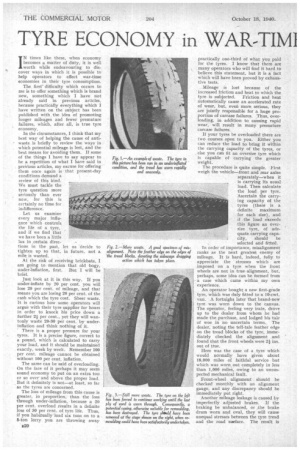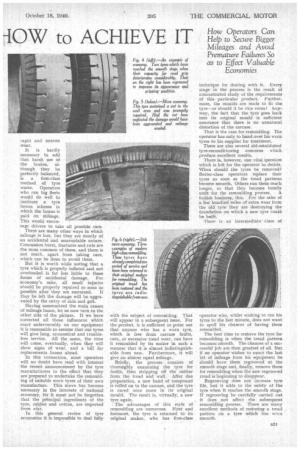TYRE ECONOMY in WAR-TIM] -10W to ACHIEVE IT
Page 54

Page 55

If you've noticed an error in this article please click here to report it so we can fix it.
How Operators Can Help to Secure Bigger Mileages and Avoid Premature Failures So as to Effect Valuable Economies
IN times like these, when economy becomes a matter of duty, it is well worth while endeavouring to discover ways in which it is possible to help operators to effect war-time economies in their tyre consumption.
The first' difficulty which occurs to me is to offer something which is brand new, something which I have not already said in previous articles, because practically everything which I have written on the subject has been published with the idea of promoting longer mileages and fewer premature failures, which, after all, is true tyre economy.
In the circumstances, I think that my best way of helping the cause of antiwaste is briefly to review the ways in which potential mileage is lost, and the best means for avoiding them. If some of the things I have to say appear to be a repetition of what I have said in previous articles, my excuse for offering them once again is that present-day conditions demand a review of this kind. We must tackle the tyre question more seriously than ever now, for this is certainly no time for indifference.
Let us examine every major influence which controls the life of a tyre, and if we find that we have been a little lax in .certain directions in the past, let us -decide to tighten up so that, in future, not a mile is wasted.
At the risk of receiving brickbats, I am going to mention that old bogy, under-inflation, first. But I will be brief.
Just look at it in this way. If you under-inflate by 20 per cent, you will lose 20 per cent, of mileage, and that means you are losing 20 per cent, of the cash which the tyre cost. Sheer waste. It is curious how some operators will argue with their tyre supplier for hours in order to knock his price down a further 21 per cent., yet they will wantonly waste 20-30 per cent, by underinflation and think nothing of it.
' There is a proper pressure for your tyres. It is a precise figure, correct to a pound, which is calculated to carry your load, and it should be maintained
• exactly, week by week. Remember 100 per cent, mileage cannot be obtained without 100 per cent. inflation.
The same can be said of overloading. On the face of it perhaps it may seem sound economy to put on an extra ton or so over" and above the proper load. . But it definitely is not—at least, so far as the tyres are concerned, The loss of mileage from this cause is greater, in proportion, than the toss through under-inflation, • because a 20 per cent, overload results in a definite loss of 30 per cent. of tyre life. Thus, if you habitually load six tons on to a 5-ton lorry you are throwing away practically one-third of what you paid for the tyres. I know that there are many operators who will find it hard to believe this statement, but it is a fact which will have been proved by exhaustive tests.
Mileage is lost because of the increased friction and heat to which the tyre is subjected. Friction and heat automatically cause an accelerated rate of wear, but, even more serious, they are jointly responsible for a huge proportion of carcase failures. Thus, overloading, in addition to causing rapid wear, will result in many premature carcase failures.
If your tyres be overloaded there are two courses open to you. Either you can reduce the load to bring it within the carrying capacity of the tyres, or else you can fit an oversize tyre which is capable of carrying the greater weight.
The procedure is quite simple. First weigh the vehicle—front and rear axles separately—when it is carrying its usual load. Then calculate the load per tyre. 'Ascertain the carrying capacity of the tyres (there is a definite maximum for each size), and if .the load exceeds this figure an oversize tyre, of adequate carrying capacity, should be selected and fitted.
In order of importance, misalignment ranks as the next greatest enemy of mileage. It is hard, indeed, fully to appreciate the stresses which are imposed on a tyre when the front wheels are not in true alignment, but, perhaps, some idea can be formed from a case which came within my own experience. .
An operator bought a new first-grade tyre, which Was duly fitted to a 10-cwt. van. A fortnight later that brand-new tyre was worn down to the canvas. The operator, feeling very irate, drove up to the dealer from whom he had made the purchase, and lodged his tale of woe in no uncertain terms. The dealer, noting the tell-tale feather edge on the tread blocks of the tyre, immediately checked the alignment and found that the front wheels were 21 ins. out of true.
Here was the case of a tyre which would normally have given about 18,000 miles of faithful service but which was worn, out completely in less than 1,000 miles, owing to an unsuspected mechanical fault.
Front-wheel alignment should be checked monthly with an alignment gauge, and any discrepancy should be immediately put right.
Another mileage leakage is caused by imperfectly adjusted brakes. If the braking be unbalanced, or .the brake drum worn and oval, they will cause unequal stresses between the tyre tread and the road surface. The result is
rapid and uneven wear.
It is hardly necessary to add that harsh use of the brakes; although they be perfectly balanced, is a first-class method of tyre waste. Operators who run big fleets would do well to institute a tyre bonus scheme in which the bonus is • paid on mileage. This would encou rage drivers to take all possible care. There are many other ways in which mileage is lost, but they are mostly of an accidental and unavoidable nature. Concussion burst, fractures and cuts are the most common of these, and there is not much, apart from taking care, which can be done to avoid them.
• But it is worth while noting that a tyre which is properly inflated and not .overloaded is far less liable to these forms of accidental damage. For economy's sake, all small injuries should be properly repaired so soon as possible after they are sustained. If they be left the damage will be aggravated by the entry of rain and grit.
Having summarized the main causes of mileage losses, let us now turn to the other side of the picture. If we have corrected all those influences which react unfavourably on our equipment it is reasonable to assume that our tyres will give long, economical and troublefree service. All the same, the time will come, eventually, when they will show signs of wear, and a bill for replacements looms ahead.
In this connection, most operators will no doubt have read with interest the recent announcement by the tyre manufacturers to the effect that they are prepared to undertake the remoulding of suitable worn tyres of their own manufacture. This move has 'become necessary in the interests of national economy, for it must not be forgotten that the principal ingredients of the tyre, rubber and cotton, are imported from afar.
In this general review of tyre economies it is impossible to deal fully• with the subject of remoulding. That will appear in a subsequent issue. For the present, it is sufficient to point out that anyone who has a worn tyre, which is free from carcase faults, cuts, or excessive tread wear, can have it remoulded by its maker in such a manner that it is almost indistinguishable from new. Furthermore,. it will give an alnibst equal mileage.
Briefly, the process consists of thoroughly examining the tyre for faults, then stripping off the rubber from the tread and wall. After due preparation, a new band of compound is rolled on to the carcase, and the tyre is cured once more in its original mould. The result is, virtually, a now tyre again.
The advantages of this style of remoulding are numerous. First and foremost, the tyre is returned to its original maker, who has first-class technique for dealing with it. Every stage in the process is the result of concentrated study of the requirements of this particular product. Furthermore, the moulds are made to fit the tyre—or should it be vice versa? Anyway, the fact that the tyre goes back into its original mould is sufficient assurance that there is no unnatural distortion of the carcase.
That is the case for remoulding. The operator has only to hand over his worn tyres to his supplier for treatment,
There are also several old-established tyre-reconditioning concerns which produce excellent results.
There is, however, one vital question which is left for the operator to decide. When should the tyres be removed? Better-class operators replace their tyres so soon as the tread patterns become smooth. Others run them much longer, so that they become totally unfit for the remoulding process. A foolish business, this. For the sake of a few hundred miles of extra wear from the o/d tyre they are destroying the foundation on which a new tyre could be built: There is an intermediate class of • operator who, whilst wishing to run his tyres to the last minute, does not want to spoil his chances of having them remoulded.
The best time to remove the tyre for remoulding is when the tread pattern becomes smooth. The chances of a successful job are then greatest of all. But if an operator wishes to exact the last bit of mileage from his equipment he should have them regrooved at the smooth stage and, finally, remove them for remoulding when the new regrooved tread is beginning to disappear.
Regrooving does not increase tyre life, but it adds to the safety of the tyre when it reaches the smooth stage. If regrooving be carefully carried ant it does not affect the subsequent remoulding process. There are many excellent methods of restoring a tread pattern on a tyre which has worn smooth.




































































































